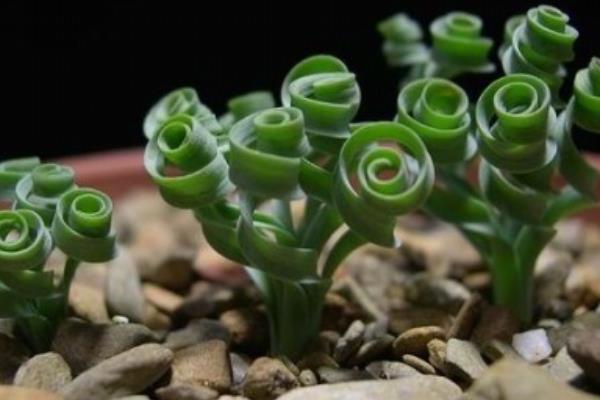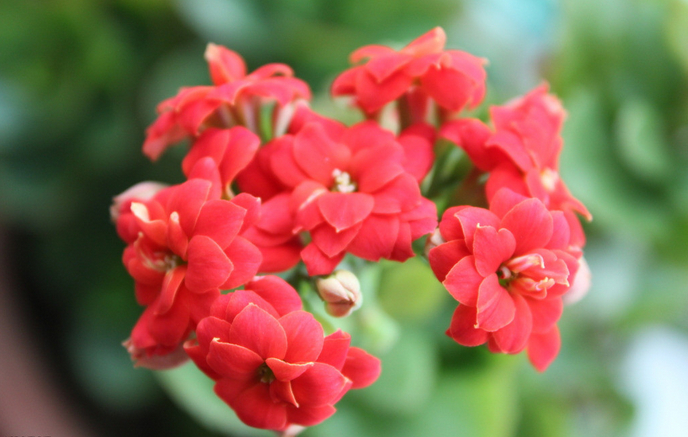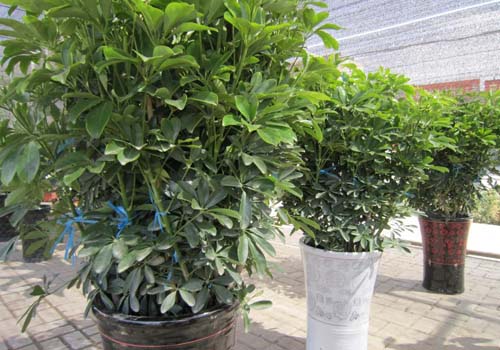What is spring grass?
Spring grass, also known as spiral grass, gets its name because its leaves are twisted and shaped like springs. it is a small potted ornamental plant newly introduced in recent years, with unique shape, simple bulbs, leaves according to different varieties, or like springs, or like kelp floating in the water, or like long curly hair, or like iron products, its lines are smooth and elegant, rich in variety, elegant and fresh in color, suitable for planting in small pots, embellished in windowsills, several cases, etc. Strange and interesting.
Spring prairie produced in South Africa, like cool, moist and sunny environment, afraid of hot and humid, resistant to semi-shade, but also resistant to drought, there is a certain cold resistance. It has the habit of dormant at high temperature in summer and growing in the cool season from autumn to spring.

When does the spring grass bloom?
The flowering period of spring grass is from February to April every year. Its flowers usually bloom when there is plenty of light and close at night.
Generally speaking, the single flower talk of spring grass will continue to open for about 5 days, but it is also difficult to blossom in rainy weather or lack of light.
Will the spring grass die after flowering?
Spring grass does not die after flowering, but it goes into dormancy. After the spring grass blossoms, the ground part will gradually wither, the corms will grow dormant in summer, the withered parts can be cut off, the bulbs and flowerpots will be placed in a cool and moist place, occasionally watered to keep the soil slightly moist, and the corms will continue to expand. When autumn comes, new leaves will sprout, and now put them on the windowsill for normal maintenance.
Growth habits of Rabdosia rubescens
Spring grass likes cool and hot, the growing period is from September to April of the following year, and the winter temperature should be kept at about 10 ℃ to 20 ℃. In this environment, spiders can continue to grow and carry out normal fertilizer and water management. If watering is controlled to make the plant dormant, no less than 0 ℃ can safely survive the winter indoors.
In the middle and last ten days of May, with the increase of temperature, the leaves on the ground gradually withered, the plant went into a dormant state, the dry leaves could be removed, the bulbs were left in the original pot for summer, and the flowerpot should be placed in a dry, ventilated and water-free place until the end of August and the beginning of September. As the weather turns cool, new buds will grow from the bulbs, and normal management can be slowly restored.
It is worth reminding that summer dormancy, plants do not have no water throughout the summer, can stay slightly moist, although the leaves have dried up. Underground bulbs will still grow, do not water in the center of dry leaves, over a summer, the bulbs grow a lot bigger.
The function of spring grass
First, the collocation of spring grass and home style
Spring grass is a common potted ornamental plant in family breeding. it can also be used as the front of the flower bed or as flower matching and illustration. It is a common small and medium-sized family potted plant, more used to beautify the home, more used to decorate the interior, placed on the desk Antai can make people at work refreshed, or placed on the bedroom balcony, can make the home full of vitality. Spring grass has a certain ornamental effect, its potted plants are placed next to computers and televisions, which can absorb radiation and reduce the absorption of indoor formaldehyde and other substances, thus purifying the air.
Second, the fengshui application of spring grass.
1. Put it in the bedroom
The bedroom is suitable for putting spring grass, the bedroom environment is quiet and more warm, if you put a spring grass, to a certain extent, the relationship between husband and wife can be more friendly, the body and mind of a hard day can be well relaxed.
2. Display in the living room
Putting a spring grass in the living room needs to choose the orientation according to the strange shape of the door, so that the living room is full of strong positive energy, increase the wealth of the family, and make the whole family harmonious and healthy.
3. Put it in the hall
The living room facing the west of the door must be brightened, and the west is gold in the five elements, so you can pot plants of gold and soil, and spring grass is the most suitable plant type. It can add metallic positive energy and have a beneficial effect on the breathing of the family and the health of the heart and lungs.
Third, the ornamental value of spring grass.
Spring grass has become a model of horticulture and family planting since it spread all over the world. it is regarded as a treasure of indoor foliage flowers and is loved by flower lovers all over the world. It has a unique shape, rapid growth and reproduction and beautiful appearance. It is not only one of the most ideal plants in the potted plant room, but also a good material for making and decorating bonsai.
Spring grass itself should be relatively fragile, she spent a lifetime of energy and inspiration to concave shape, but did not exercise her body very strong, so once flowering is likely to cause a lot of nutritional loss to herself. It takes a period of dormancy to restore the state.
Spring grass Albucanamaquensis spring sketch guide: how to raise spring grass / spring grass how to breed spring grass business card spring grass spring grass also known as spring grass, also known as spiral grass, because the leaves twisted and twisted, shaped like a spring, is a newly introduced small pot ornamental plant in recent years, its shape is unique, the bulb is simple, the leaf is different according to the variety, or like spring, or like kelp floating in the water. Or like curly long hair, or like iron products, its lines are smooth and elegant, rich in variety, light and elegant and fresh, suitable for planting in small pots, embellished in windowsills, cases and other places, strange and interesting. The Sentinel flower is a perennial bulbous succulent plant belonging to the family Hyacinthaceae (Hyacinthaceae). The plant has round or irregular bulbs. The bulb is composed of layers of thick fleshy scales, the epidermis of the underground part is yellow-white, and the exposed part is green-white after sun exposure. The fleshy leaves are drawn from the top of the bulb, linear or banded, growing erect at first, then gradually twisted and twisted, much like a spring, some varieties have white burrs on the leaves, pedicels drawn from the leaves, racemes, florets drooping, petals yellowish on the front, yellowish green on the back, some varieties have a light fragrance, and the flowers usually open when the sun is full, close in the evening, and so close day and night. A single flower can bloom for about 5 days, but it is difficult to bloom on rainy days or insufficient light in the cultivation environment, and the flowering period is from March to April. Spring grass ecological habits spring grassland produced in South Africa, like cool, moist and sunny environment, afraid of hot and humid, resistant to semi-shade, but also resistant to drought, there is a certain degree of cold resistance. It has the habit of dormant at high temperature in summer and growing in the cool season from autumn to spring. The cultivation techniques and management habits of spring grass: spring grass likes cool and hot, and the main growth period is from September to April of the following year. It is appropriate to maintain a temperature of 10 ℃ to 20 ℃ in winter. In this environment, the plant can continue to grow and normal fertilizer and water management can be carried out. If watering is controlled to make the plant dormant, no less than 0 ℃ can safely survive the winter indoors. In the middle and last ten days of May, with the increase of temperature, the leaves on the ground gradually withered, the plant went into a dormant state, the dry leaves could be removed, the bulbs were left in the original pot for summer, and the flowerpot should be placed in a dry, ventilated and water-free place until the end of August and the beginning of September. As the weather turns cool, new buds will grow from the bulbs, and normal management can be slowly restored. It is worth reminding that summer dormancy, plants do not have no water throughout the summer, can stay slightly moist, although the leaves have dried up. Underground bulbs will still grow, do not water in the center of dry leaves, over a summer, the bulbs grow a lot bigger. Temperature: no less than 5 ℃ can survive the winter safely. Lighting: spring grass likes light, the growth period should be given sufficient light, if the lack of light will make the leaves weak, and the degree of curl is poor, it is difficult to highlight the unique charm of spring grass. On the other hand, the leaves of the plants growing in sufficient sunshine are low and stout, twisted and twisted, with high ornamental value, but sunshade nets should still be built after April to avoid hot sun exposure and prevent leaf tips from drying up. Water and fertilizer: spring grass likes a humid environment, and it is appropriate to keep the soil moist during the growing period. If there is a long-term drought and lack of water, the plant will not die, but the growth will stagnate, the leaves will yellowing, and even wither; while the long-term stagnant water in the basin soil will cause the bulb to rot. Water can often be sprayed to the plant to increase air humidity and prevent the top of the leaves from drying up. In summer, in order to avoid flooding in the rainy season, the flowerpot can be placed on the shelf or on a stage with a certain height, and pay attention to control watering to prevent the bulb from rotting due to stagnant water, but the pot soil can not be completely dry to prevent the bulb from drying up. The peak period of plant growth is from October of each year to April of the following year. Mature thin liquid fertilizer or compound fertilizer is applied once a month to provide sufficient nutrients to make the plant grow vigorously. After the flower is extracted in spring, 0.5% potassium dihydrogen phosphate solution is sprayed 2 to 3 times to promote flowering. Pollination: after flowering, different plants should be selected for artificial pollination to make the plants bear fruit, and the seeds should be harvested after maturity, so as not to scatter them; if there are no seeds, the remaining pedicels should be cut off in time after flowering, so as not to consume too much nutrients. Change the basin: spring grass is generally changed once a year at the end of August, the basin soil requires fertile and loose, rich in humus, has good drainage and permeability, can be mixed with 3 portions of saprophytic soil or peat soil, 2 parts of vermiculite or sandy soil, and mixed with a small amount of bone powder. Cut off the rotten root system when changing the basin, plant the bulb out of the soil 1 / 3 or so, pour water after planting and maintain it in a place with sufficient light. After that, pay attention to keep the soil moist, and soon new leaves will grow from the top of the bulb. The propagation mode of spring grass the reproduction of spring grass can be done by means of ramet and sowing. Ramet: can be combined with autumn pot change, the method is to break off the small bulbs sprouting around the large bulb and plant them in the culture soil, no matter they have roots or no roots can survive. Sowing: this method is suitable for mass reproduction and is carried out in autumn. After sowing, it is covered with thin soil and covered with glass to keep the soil and air moist and has a high emergence rate. After sowing and at the seedling stage, in order to avoid flushing the seeds or seedlings out of the soil during watering, the flowerpot should be watered and the flowerpot should be placed in a water basin to slowly wet the soil from the drainage hole at the bottom of the flowerpot. There are not many diseases and insect pests of spring grass, which mainly include snails and nematodes in the soil. When planting, the soil can be treated at high temperature to kill pests and eggs in the soil. Insecticidal pesticides such as carbofuran can also be mixed in the culture soil, but because carbofuran is a highly toxic pesticide and its degradability is poor, it will cause harm to the environment if it is not used properly, so we must be careful when using it. The main diseases of spring grass are bulb rot caused by long-term stagnant water due to poor soil permeability, and leaf tip dryness caused by dry air, long-term lack of soil water and other factors, which can be prevented by improving the cultivation environment. Pictures of spring grass
- Prev

Are longevity flowers suitable for indoor cultivation?
Longevity flowers have many colors, easy to raise and other advantages-the body is very popular with flower friends, some flower friends want longevity flowers to grow indoors, but do not know if longevity flowers are suitable for indoor cultivation, longevity flowers can be raised indoors, but we should take a look at the specific situation. In the first case, the longevity flowers are watched indoors during the flowering period.
- Next

The Culture method of Ping an Tree
Ping an tree is a foliage plant loved by many flower friends in recent years. it is a small evergreen tree of Cinnamomum camphora of Lauraceae. Its real name is Lanyu cinnamon. It turns out that it is mostly produced in Lanyu Island. Its aliases include Hongtouyu cinnamon, Hongtoushan cinnamon, Fanglan mountain cinnamon, big leaf cinnamon, Taiwan cinnamon and so on. After many florists get started
Related
- Fuxing push coffee new agricultural production and marketing class: lack of small-scale processing plants
- Jujube rice field leisure farm deep ploughing Yilan for five years to create a space for organic food and play
- Nongyu Farm-A trial of organic papaya for brave women with advanced technology
- Four points for attention in the prevention and control of diseases and insect pests of edible fungi
- How to add nutrient solution to Edible Fungi
- Is there any good way to control edible fungus mites?
- Open Inoculation Technology of Edible Fungi
- Is there any clever way to use fertilizer for edible fungus in winter?
- What agents are used to kill the pathogens of edible fungi in the mushroom shed?
- Rapid drying of Edible Fungi

